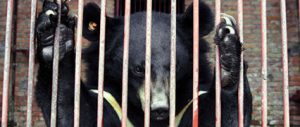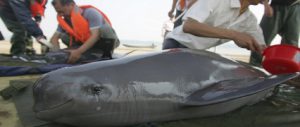On October 11, at the age of two years and two months, giant panda Taotao went home.
This was China’s second attempt to introduce a giant panda born through artificial insemination into the wild. Unlike last time, however, Taotao was born and raised in an environment designed to mimic his natural habitat.
There are no precedents to follow in this process, and the failure of the release of another panda, Xiang Xiang, five years ago has cast a shadow over the programme. But that disappointment spurred the researchers at the Wulong Panda Centre into even greater efforts to prepare Taotao for the wild.
The first step back
In late October, the mountains of Liziping Nature Reserve were clad in autumn colours. It was here, 2,500 metres above sea level, in a mountain gully hidden by bamboo forests, that Taotao went into the wild.
See also: Shame victory for China’s pandas
Taotao has been implanted with an identification chip, and wears a collar carrying both a GPS tracker and a wireless sensor. Every hour, staff triangulate his position.
“You can triangulate a location with two signals, but we use three to be a bit more accurate,” says Zhou Xiao, a member of the centre’s team. If the signals show that Taotao is particularly active, the team increases monitoring to every half hour.
They have found that Taotao is sticking to one small area. The researchers think he’s getting used to his new environment. The same happened in 2009, when rescued panda Luxin was returned to the wild and went three months before making any long journeys.
When Taotao’s activities have stabilised, the researchers will make regular trips to collect stool samples, in order to monitor his health. But they will wait, explains Zhou, because at the moment he needs to use his excrement to mark out his new territory.
And it really is new. Taotao was born in a training ground in Wulong Nature Reserve. It’s a 450-kilometre drive from Liziping, though in terms of altitude and geography the two areas are similar.
The researchers hope that Taotao’s arrival will be the first step in strengthening the local panda population. But more importantly, they hope to avoid a repeat of the tragedy that took place five years ago.
Xiang Xiang’s shadow
For the past five years, the Wulong Panda Centre has been haunted by the death of a panda named Xiang Xiang.
In 2003, the centre launched its first programme training a captive-born panda for release to the wild. Three years later, on April 28, 2006, five-year-old male panda Xiang Xiang was released in Wulong, becoming the first captive-born panda ever to be “returned” to the wild.
But things did not go well. In December the same year Xiang Xiang was injured fighting with other pandas. He was retrieved for treatment and then sent back again.
That move was later criticised. On January 7, 2007, less than a year after his second release, Xiang Xiang’s tracker stopped moving. On January 29, a search team found his corpse.
The research team was distraught, and criticism from outside the centre was fierce – returning Xiang Xiang to the wild after his injury was simply “sending him to its death”, some said.
“The public didn’t understand that this was a research project, and any research project can fail,” says Zhang Hemin, director of the centre, who decided to push on with the programme training pandas for return to the wild.
In December, 2007, less than a year after Xiang Xiang’s death, Zhang announced the start of a second phase of the programme, and use of a new training method. Huang Yan, a senior official at the centre, was in charge. He explained that the release of Xiang Xiang had failed because humans had been too involved in raising the animal. The new project would see the cub raised by its mother, and the human impact minimised.
That meant the cub would be born in a semi-wild environment and raised by its mother. The mother would be tended by human keepers, but the cub would not be aware of them. That meant the mother had to have experience of living in the wild, and to have raised cubs before. A panda named Caocao, who had been rescued from the wild when young, was found to fit the bill.
To minimise exposure to humans, staff approaching the panda would dress in panda suits, smeared with panda excrement and urine, and avoid speaking. They even had their costumes fitted with devices to play panda noises to appear more realistic.
The benefits were clear. Xiang Xiang hadn’t known to avoid leeches in the wild and was plagued by them. But Taotao didn’t suffer the same way.
“This shows that his mother taught him well, and that’s something we could never have done ourselves,” says Zhang. Xiang Xiang’s death was not for nothing – it showed the centre that it was on the wrong path and pointed it in a new direction.
In the past, panda cubs have been taken immediately after birth to sterile incubators. While it was difficult, this time Huang Yan made sure he didn’t interfere: “This is the kind of environment wild pandas should be raised in.” Despite their worries, the researchers found that Taotao grew up with natural immunity – even in the dirt and hardship of the great outdoors, he didn’t get sick. In fact, he was less prone to illness than the other cubs.
The researchers also saw that Taotao quickly learned to climb trees, at the age of four months, after only one lesson from Caocao. Human-reared pandas of the same age couldn’t do this. In the wild, pandas send their cubs up trees to keep them safe. Taotao could spend two or three days up a tree, and was able to tell that recordings of other pandas were fake when researchers tried to lure him down.
Taotao also developed an excellent sense of direction and ability to find water – and more importantly, he was very wary of humans.
Keeper Wu Daifu said that Xiang Xiang was friendly with humans, as they had raised him. But Taotao would growl at the keepers, even in their panda suits. In the end, Xiang Xiang died helpless, while Taotao has taken naturally to the wild, at least so far.
More money – and pandas – to play with
Despite criticism and setbacks, the centre has stuck to its plans to train pandas for release to the wild – because its experts believe it is now both feasible and necessary.
Up until 1999, the number of pandas in captivity was in decline – any research programme had to take pandas from the wild. It was only in 2000 that Zhang and his team beat the three problems of captive breeding: bringing female pandas into heat; getting pandas to mate and become pregnant; and keeping the cubs alive. Over the following six years, all new cubs survived, and the number of captive pandas rose steadily.
China now has 342 pandas raised in captivity, enough to ensure genetic diversity for the next century. No more are needed. “To put it simply,” Zhang says, “we’ve got the capital to work with.”
Meanwhile, the outlook for panda habitats is bleak. Human activity has fragmented and isolated panda populations. Without human intervention, breeding may be reduced, perhaps even leading to extinction in the wild. Releasing pandas to strengthen small populations is an urgent task.
Making all this possible are China’s changed financial circumstances: “Raising animals in the wild for later release is a technique for developed nations,” says Huang. It takes money.
The Wulong Semi-Wild Facility has three different sections, each designed for a specific stage of the animals’ training, ranging in size from 2,000-square metres to a square kilometre. Building just one of these sections can cost 3 to 4 million yuan (US$480,000 to US$640,000). “The pandas get through huge amounts of bamboo, and once you’ve used one section for a year you need to leave it for three years to allow the bamboo to grow back,” explains Huang. Fortunately, the state is giving its full support to the project.
Of course, you could keep the pandas in comfortable cages. “But that’s the easy option,” says Zhang, the main advocate for the release programme. “This is the direction we must take, or we aren’t doing our jobs.”
This article was originally published in Southern Weekend




